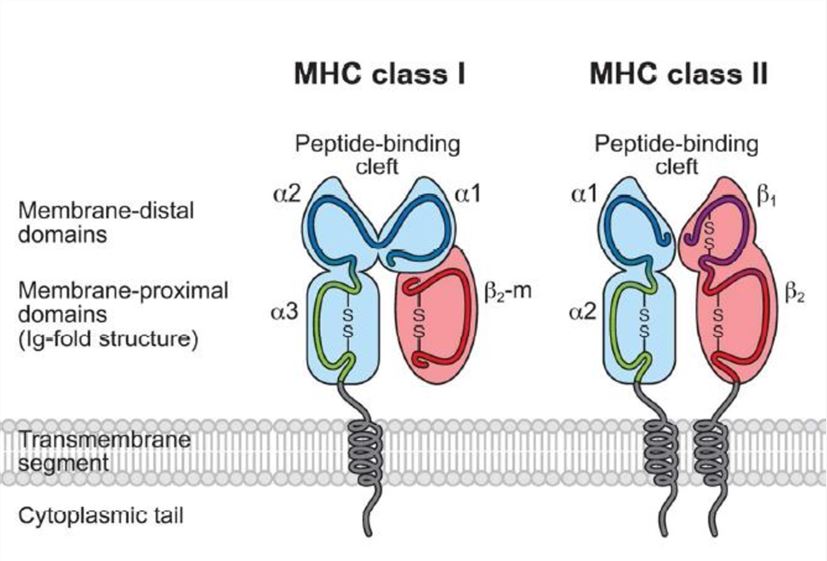
- MHC is a cluster of extensively studied genes located on chromosome 6 in humans that code for MHC molecules.
- MHC molecules are glycoprotein in nature that acts as receptor on the cell surface of antigen presenting cells (APCs). They act as antigen presenting structure and play vital role in immune recognition, including interaction between T cells and other cell types.
- Among many important genes in the human MHC, human leukocyte antigens also known as HLA encode different types of MHC proteins
- MHC molecules are known to bind peptide antigens and present them to T-cells. Thus, these are responsible for antigen recognition by the T-cell receptors.
- T-cell receptor is different from antibody. Antibody molecules interact with antigens directly whereas T-cell receptor only recognizes antigen presented by MHC molecules on another cell, the antigen-presenting cell.
Types of MHC:
A. Class I MHC:
- These proteins consist of two chains which are non-covalently associated with each other.
- Trans-membrane glycoprotein or α chain of molecular weight 45 KDa.
- The α-chain is encoded by polymorphic gen; HLA-A, -B and –C genes.
- The α-chain consists of a hydrophobic trans-membrane segment and hydrophilic cytoplasmic tails that help it anchor on the plasma membrane.
- It is composed of 3 domains (α1, α2 and α3). Each domain contains about 90 amino acids, a transmembrane domain of about 25 hydrophobic amino acids followed by short stretch of charged (hydrophilic) amino acids of cytoplasmic tails of 30 amino acids.
- α1 and α2 domains interact to form a deep groove on the top which is a peptide binding cleft where peptide antigen of 8-10 amino acids can bind.
- α3 and β2 are organized into β-pleated sheets resulting in the formation of immunoglobulin fold. Since α-chain and β2 microglobulin have this immunoglobulin fold, they are classified as member of immunoglobulin super-family receptor.
- Non-MHC encoded polypeptide of 12,000 KDa that is a β-chain known as β2-microglobulin.
- It is a protein encoded by a highly conserved gene located in different chromosome.
- It is similar in size and organization to α3 domain of α chain.
- β2 microglobulin does not contain transmembrane region.
- Trans-membrane glycoprotein or α chain of molecular weight 45 KDa.
- All nucleated cells can express class I MHC on their surfaces in the body.
- The major function of class I MHC proteins is the presentation of peptide antigens to CD8+ TC cells.
B. Class II MHC:
- These proteins are encoded by the HLA-D region, which further consists of 3 sets (HLA-DP, -DQ and –DR).
- The HLA-D locus encoded proteins are made up of non-covalently associated trans-membrane glycoproteins; one with molecular weight 33 KDa α-chain and the other with 29 KDa β-chain.
- α-chain and β-chain further consist of two domains (α1 and α2) and (β1 and β2) respectively.
- The peptide biding cleft is an open ended groove formed between α-chain and β-chain at proximal end. Antigenic peptide 13-18 amino acids long, can bind on the cleft.
- Class II MHC locus also includes genes that encode proteins involved in antigen-processing e.g. transporter proteins (TAP).
- Unlike Class I proteins, they have a restricted tissue distribution and are chiefly found on antigen-presenting cells. e. g. macrophages, B cells, dendritic cells etc.
- Major function of MHC-II is to bind peptide antigen and present to CD4+ TH cells (T helper cells).
- It also plays a significant role in rapid rejection of tissue grafts and in mixed lymphocyte reaction (MLR).

C. Class III MHC:
- The class III MHC locus encodes several proteins having function little in common with Class I and Class II MHC.
- They code for proteins having immune functions, including components of the compliment system (C4, C2 and factor B) and several molecules like cytokines (tumor necrosis factor) involved in inflammation.